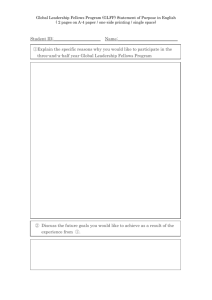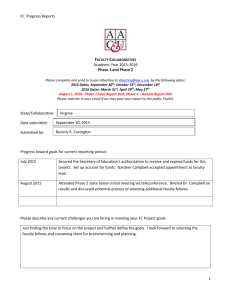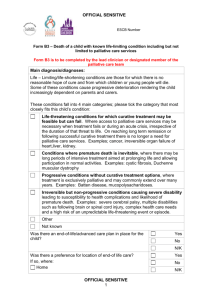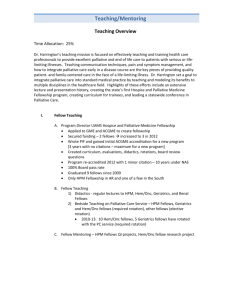Hospice and Palliative Medicine
advertisement
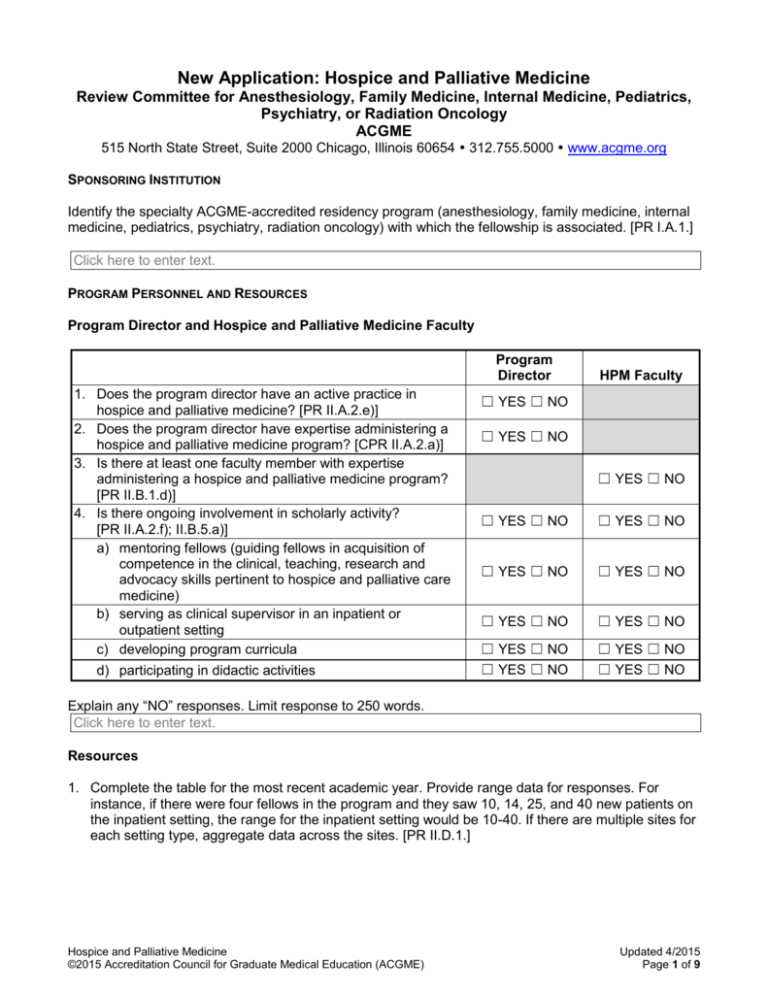
New Application: Hospice and Palliative Medicine Review Committee for Anesthesiology, Family Medicine, Internal Medicine, Pediatrics, Psychiatry, or Radiation Oncology ACGME 515 North State Street, Suite 2000 Chicago, Illinois 60654 312.755.5000 www.acgme.org SPONSORING INSTITUTION Identify the specialty ACGME-accredited residency program (anesthesiology, family medicine, internal medicine, pediatrics, psychiatry, radiation oncology) with which the fellowship is associated. [PR I.A.1.] Click here to enter text. PROGRAM PERSONNEL AND RESOURCES Program Director and Hospice and Palliative Medicine Faculty Program Director 1. Does the program director have an active practice in hospice and palliative medicine? [PR II.A.2.e)] 2. Does the program director have expertise administering a hospice and palliative medicine program? [CPR II.A.2.a)] 3. Is there at least one faculty member with expertise administering a hospice and palliative medicine program? [PR II.B.1.d)] 4. Is there ongoing involvement in scholarly activity? [PR II.A.2.f); II.B.5.a)] a) mentoring fellows (guiding fellows in acquisition of competence in the clinical, teaching, research and advocacy skills pertinent to hospice and palliative care medicine) b) serving as clinical supervisor in an inpatient or outpatient setting c) developing program curricula d) participating in didactic activities HPM Faculty ☐ YES ☐ NO ☐ YES ☐ NO ☐ YES ☐ NO ☐ YES ☐ NO ☐ YES ☐ NO ☐ YES ☐ NO ☐ YES ☐ NO ☐ YES ☐ NO ☐ YES ☐ NO ☐ YES ☐ NO ☐ YES ☐ NO ☐ YES ☐ NO ☐ YES ☐ NO Explain any “NO” responses. Limit response to 250 words. Click here to enter text. Resources 1. Complete the table for the most recent academic year. Provide range data for responses. For instance, if there were four fellows in the program and they saw 10, 14, 25, and 40 new patients on the inpatient setting, the range for the inpatient setting would be 10-40. If there are multiple sites for each setting type, aggregate data across the sites. [PR II.D.1.] Hospice and Palliative Medicine ©2015 Accreditation Council for Graduate Medical Education (ACGME) Updated 4/2015 Page 1 of 9 Specify the time frame for data: From: Click here to enter a date. To: Click here to enter a date. Specify the range Specify the range of Specify the of pediatric adult patients seen range of new patients seen by by fellows patients seen by fellows (patients (patients 21 or Settings fellows under 21) older) Inpatient consult team/unit Range Range Range Dedicated palliative care/hospice Range Range Range unit Home hospice experience Range Range Range Long-term care Range Range Range Ambulatory care setting Range Range Range Total Total Total Total 2. Describe how fellows gain experience providing care to pediatric patients. [PR II.D.1.b)] (Limit response to 250 words) Click here to enter text. 3. Describe how the program ensures fellows become competent caring for a patient population with a broad range of diagnoses and palliative care needs, including patients with advanced conditions, and of diverse socioeconomic and cultural backgrounds. [PR II.D.1.; II.D.1.d)] (Limit response to 250 words) Click here to enter text. 4. Provide a narrative description of the inpatient acute care experience. [PR II.D.2.a)] (Limit response to 250 words) Click here to enter text. 5. Provide a narrative description of the fellows’ experience in hospice home care. [PR II.D.2.a)] (Limit response to 250 words) Click here to enter text. 6. Provide a narrative description of fellow’s ambulatory experience. [PR II.D.2.a)] (Limit response to 250 words) Click here to enter text. EDUCATIONAL PROGRAM Patient Care 1. Indicate the settings and activities in which fellows will demonstrate competence in each of the following areas of patient care. Also indicate the method(s) used to assess competence. Competency Area Settings/Activities Coordinating, leading, and Click here to enter text. facilitating key events in patient Hospice and Palliative Medicine ©2015 Accreditation Council for Graduate Medical Education (ACGME) Assessment Method(s) Click here to enter text. Updated 4/2015 Page 2 of 9 Competency Area care, such as family meetings, consultation around goals of care, advance directive completion, conflict resolution, withdrawal of life-sustaining therapies, and palliative sedation, involving other team members as appropriate [PR IV.A.2.a).(1).(a)] Providing care to patients and families that reflects unique characteristics of different settings along the palliative care spectrum [PR IV.A.2.a).(1).(b)] Recognizing signs and symptoms of impending death and appropriately caring for the imminently dying patient and his or her family members [PR IV.A.2.a).(1).(c)] Providing basic counseling to the bereaved, and the ability to identify when additional psychosocial referral is required [PR IV.A.2.a).(1).(d)] Providing palliative care throughout the continuum of serious illness while addressing physical, intellectual, emotional, social, and spiritual needs and facilitating patient autonomy, access to information, and choice [PR IV.A.2.a).(1).(e)] Settings/Activities Assessment Method(s) Click here to enter text. Click here to enter text. Click here to enter text. Click here to enter text. Click here to enter text. Click here to enter text. Click here to enter text. Click here to enter text. 2. Indicate the settings and activities in which fellows will demonstrate competence in each of the following procedures considered essential for the practice of hospice and palliative medicine. Also indicate the method(s) used to assess competence. Competency Area Assessment, interdisciplinary care planning, management, coordination, and follow-up of patients with - serious illness [PR IV.A.2.a).(2).(a)] Providing patient- and familycentered care that optimizes quality of life by anticipating, preventing, and treating suffering [PR IV.A.2.a).(2).(a).(i)] Settings/Activities Click here to enter text. Assessment Method(s) Click here to enter text. Click here to enter text. Click here to enter text. Hospice and Palliative Medicine ©2015 Accreditation Council for Graduate Medical Education (ACGME) Updated 4/2015 Page 3 of 9 Medical Knowledge Indicate the settings and activities (lectures, conferences, journal clubs, clinical teaching rounds, etc.) in which fellows will develop competence in their knowledge in each of the following areas. Also indicate the method(s) used to assess competence. Competency Area The scientific method of problem solving and evidence-based decision making and develop commitment to lifelong learning, and an attitude of caring that is derived from humanistic and professional values [PR IV.A.2.b).(1)] Ethical issues, clinical utilization, and financial outcomes of palliative care [PR IV.A.2.b).(2)] Knowledge and skills of primary and consultative practice [PR IV.A.2.b).(3)] Settings/Activities Click here to enter text. Assessment Method Click here to enter text. Click here to enter text. Click here to enter text. Click here to enter text. Click here to enter text. Practice-based Learning and Improvement 1. Briefly describe one planned quality improvement activity or project that will allow fellows to demonstrate the ability to analyze, improve, and change practice or patient care. Describe planning, implementation, evaluation, and provisions of faculty member support and supervision that will guide this process. [PR IV.A.2.c).(1)] (Limit response to 400 words) Click here to enter text. 2. Briefly describe one example of a learning activity in which fellows engage to develop the skills needed to locate, appraise, and assimilate evidence from scientific studies and apply it to their patients' health problems. [PR IV.A.2.c).(2)] (Limit response to 400 words) The description should include: Locating information Appraising information Assimilating evidence information (from scientific studies) Applying information to patient care Click here to enter text. 3. Briefly describe one example of a learning activity in which fellows will develop competence in teaching personnel such as nurses, allied health personnel, medical students, residents, and/or other fellows. [PR IV.A.2.c).(3)] (Limit response to 400 words) Click here to enter text. Interpersonal and Communication Skills Hospice and Palliative Medicine ©2015 Accreditation Council for Graduate Medical Education (ACGME) Updated 4/2015 Page 4 of 9 1. Briefly describe one learning activity in which fellows develop interpersonal and communication skills that result in the effective exchange of information and collaboration with patients, their families, and health professionals. [PR IV.A.2.d)] (Limit response to 400 words) Click here to enter text. 2. Briefly describe one learning activity in which fellows will demonstrate the ability to educate patients/families about the medical, social, and psychological issues associated with serious illness, including demonstrating these skills in common situations occurring with serious, life-threatening illness and at the end of life, and writing an informative, situationally appropriate note in the medical record. [PR IV.A.2.d).(1); IV.A.2.d).(1).(a)] (Limit response to 400 words) Click here to enter text. 3. Briefly describe one learning activity in which fellows organize and facilitate or co-facilitate a family meeting. [PR IV.A.2.d).(2)] (Limit response to 400 words) Click here to enter text. 4. Briefly describe one learning activity in which fellows collaborate effectively with others as a member or leader of an interdisciplinary team. [PR IV.A.2.d).(3)] (Limit response to 400 words) Click here to enter text. 5. Briefly describe one learning activity in which fellows collaborate effectively with health care personnel in all settings in the palliative care continuum, including hospitals, palliative care units, nursing homes, home and inpatient hospice, and other community resources. [PR IV.A.2.d).(4)] (Limit response to 400 words) Click here to enter text. Professionalism Briefly describe the learning activity(ies), other than lecture, by which fellows develop a commitment to carrying out professional responsibilities and an adherence to ethical principles. [PR IV.A.2.e)] (Limit response to 400 words) Click here to enter text. Systems-based Practice 1. Briefly describe the learning activity(ies) through which fellows develop an awareness of and responsiveness to the larger context and system of health care, as well as the ability to call effectively on other resources in the system to provide optimal health care. [PR IV.A.2.f)] (Limit response to 400 words) Click here to enter text. 2. Briefly describe one learning activity in which fellows will participate in systems improvement activities based on clinical practice or patient and family satisfaction data, in personal practice, team practice, and within institutional settings. [PR IV.A.2.f).(1)] (Limit response to 400 words) Hospice and Palliative Medicine ©2015 Accreditation Council for Graduate Medical Education (ACGME) Updated 4/2015 Page 5 of 9 Click here to enter text. 3. Briefly describe one learning activity in which fellows will work effectively in various settings for organizing, regulating, and financing care for patients at the end of life. [PR IV.A.2.f).(2)] (Limit response to 400 words) Click here to enter text. 4. Briefly describe one learning activity in which fellows will demonstrate knowledge in the organizational and administrative aspects of operating and maintaining a hospice care program. [PR IV.A.2.f).(3)] (Limit response to 400 words) Click here to enter text. 5. Briefly describe one learning activity in which fellows will demonstrate a systems-based awareness of patient safety, including disclosure of events to patients. [PR IV.A.2.f).(4)] (Limit response to 400 words) Click here to enter text. 6. Briefly describe one learning activity in which fellows will reflect on personal attitudes, values, strengths, vulnerabilities, and personal experiences to optimize self-care and capacity to meet the needs of patients and families. [PR IV.A.2.f).(5)] (Limit response to 400 words) Click here to enter text. Curriculum Organization and Fellow Experiences 1. Provide the didactic exercises and the fellows’ role in such exercises. Provide the type and frequency of experience, whether faculty members will participate in didactic exercises, and the fellows’ role in didactic exercises. Add rows as necessary. [PR IV.A.3.g)-g).(2)]. Didactic Exercises: Hospice and palliative medicine conferences Journal club Research seminars Other: Other: Other: Other: Frequency (e.g., weekly, monthly) Do some faculty members participate in didactic exercise: (Y/N) Fellows’ role in didactic exercise: Attend (A) or Present (P) or Both (B) 2. Provide responses to the following questions about how the particular experiences of the program are structured. a) Inpatient Setting Hospice and Palliative Medicine ©2015 Accreditation Council for Graduate Medical Education (ACGME) Updated 4/2015 Page 6 of 9 (1) Is the inpatient experience at least four months or equivalent in duration? [PR IV.A.3.c)] ......................................................................................................................... ☐ YES ☐ NO (2) Does the inpatient setting provide access to the full range of services usually ascribed to an acute care general hospital? [PR IV.A.3.c).(1)] ................................................. ☐ YES ☐ NO (3) Does the inpatient setting have access to a range of consulting physicians, including those with expertise in interventional pain management? [PR IV.A.3.c).(2)] ............... ☐ YES ☐ NO b) Home Hospice Experience (1) Does the fellow conduct 25 home hospice visits during the fellowship? [PR IV.A.3.e).(1)] ........................................................................................................................ ☐ YES ☐ NO (2) Are all home hospice visits provided through a Medicare-certified program? [PR IV.A.3.e).(1)] .............................................................................................. ☐ YES ☐ NO (3) Does the hospice program care for children? [PR IV.A.3.e)] ............................. ☐ YES ☐ NO If “NO,” do fellows see children with serious illness through a pediatric home care program? [PR IV.A.3.e)] ................................................................................................... ☐ YES ☐ NO c) Long-term Care (1) Is the long-term care experience at least one month or equivalent in duration? [PR IV.A.3.l)]..................................................................................................... ☐ YES ☐ NO (2) Does the experience provide access to meaningful longitudinal care of patients on a consultation team or a hospice or palliative care unit? [PR IV.A.3.l)] ................ ☐ YES ☐ NO (3) Is a skilled nursing facility, a chronic care hospital, or a children’s rehab center used to provide required long-term care experiences? [PR IV.A.3.d).(2).(b)] ................. ☐ YES ☐ NO Explain any “NO” responses. (Limit response to 250 words) Click here to enter text. d) Ambulatory Care (1) Do fellows have a supervised experience in an outpatient hospice clinic or day hospital, a dedicated palliative care clinic, or other ambulatory practice providing relevant palliative interventions to patients with serious conditions? [PR IV.A.3.f)] ........................ ☐ YES ☐ NO (2) Is the ambulatory experience at least six months in duration? [PR IV.A.3.f).(1)] ......................................................................................................................... ☐ YES ☐ NO If “NO” for (2), explain. (Limit response to 250 words) Click here to enter text. 3. Describe the elective opportunities available to fellows. [PR IV.A.3.i)] (Limit response to 250 words) Click here to enter text. Hospice and Palliative Medicine ©2015 Accreditation Council for Graduate Medical Education (ACGME) Updated 4/2015 Page 7 of 9 FELLOW DUTY HOURS IN THE LEARNING AND WORKING ENVIRONMENT Interdisciplinary Team 1. Complete the following table for each distinct interdisciplinary team (IDT) in which fellows participate during the program. Provide evidence of at least one IDT involved in fellowship education. Copy table for each additional team as necessary, along with identifying the setting of the IDT, provide the name and/or location of the facility/site. Provide the name and specialty of physician faculty members and indicate the presence of other support staff. [PR VI.F.1 – VI.F.1.a)] IDT # Identify Members of the IDT 1 Specify Physician Faculty Member(s) (name and specialty) Click here to enter text. Other Support Staff Psychosocial Clinician YES ☐ NO ☐ Nurse ☐ ☐ Chaplain ☐ ☐ Other: (specify) ☐ ☐ IDT # Identify Members of the IDT 2 Specify Physician Faculty Member(s) (name and specialty) Click here to enter text. Other Support Staff Psychosocial Clinician YES ☐ NO ☐ Nurse ☐ ☐ Chaplain ☐ ☐ Other: (specify) ☐ ☐ IDT # Identify Members of the IDT 3 Specify Physician Faculty Member(s) (name and specialty) Click here to enter text. Other Support Staff Psychosocial Clinician YES ☐ NO ☐ Nurse ☐ ☐ Chaplain ☐ ☐ Other: (specify) ☐ ☐ Identify the Setting of IDT ☐ Inpatient consult team/unit ☐ Dedicated palliative care/hospice unit ☐ Long-term care ☐ Home hospice care ☐ Ambulatory care ☐ Other: (specify) Identify the Setting of IDT ☐ Inpatient consult team/unit ☐ Dedicated palliative care/hospice unit ☐ Long-term care ☐ Home hospice care ☐ Ambulatory care ☐ Other: (specify) Identify the Setting of IDT ☐ Inpatient consult team/unit ☐ Dedicated palliative care/hospice unit ☐ Long-term care ☐ Home hospice care ☐ Ambulatory care ☐ Other: (specify) Hospice and Palliative Medicine ©2015 Accreditation Council for Graduate Medical Education (ACGME) Updated 4/2015 Page 8 of 9 2. Briefly describe how fellows interact/function with the IDT. Describe fellow responsibilities on the IDT. (Limit response to 250 words) Click here to enter text. Hospice and Palliative Medicine ©2015 Accreditation Council for Graduate Medical Education (ACGME) Updated 4/2015 Page 9 of 9
